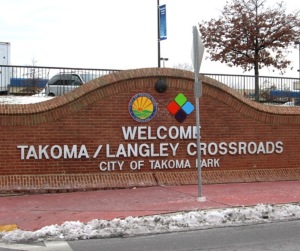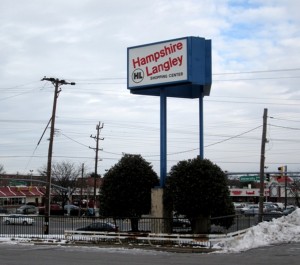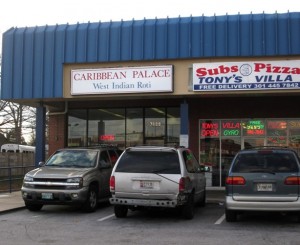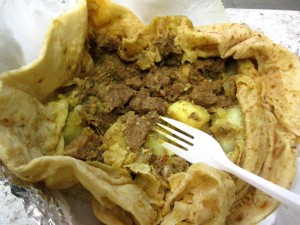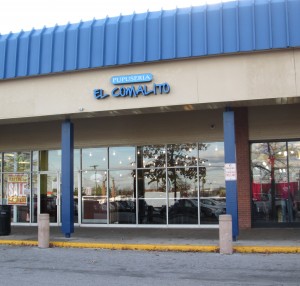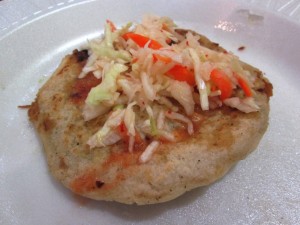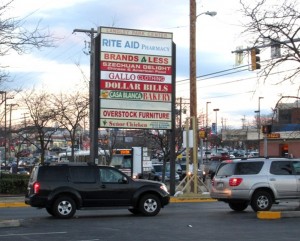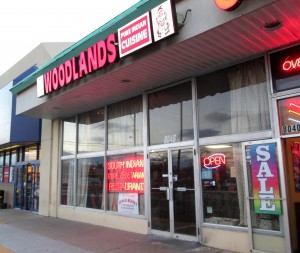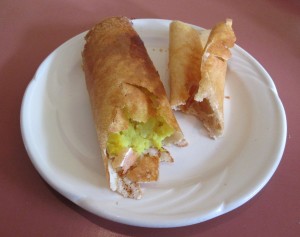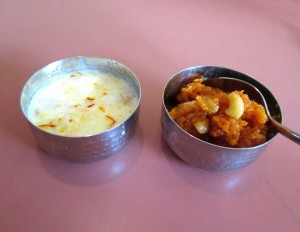(by Corbo Eng)
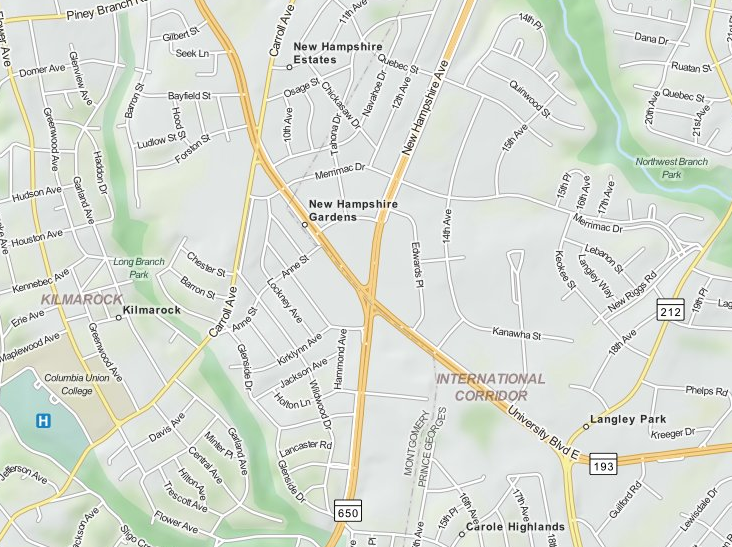
The Takoma/Langley Crossroads (at the junction of New Hampshire Ave. – MD 650 & University Blvd. – MD 193)
As a New Yorker might escape the urban core of Manhattan to the outer boroughs to seek good ethnic eats, Washingtonians similarly do the same; but, while Brooklyn and Queens are still within the sprawling city limits of that great metropolis, once one travels a comparable distance to venture out of DC’s urban center, one is likely to have crossed into neighboring Maryland or Virginia.
It’s here that one will find the area’s most vibrant and largest ethnic communities. For instance, one can point to Arlington, Falls Church, and Annandale in Virginia and Rockville or Wheaton in Maryland as popular places where immigrant businesses have expanded otherwise staid dining options. There are noteworthy choices: pollo a la brasa in Arlington, bánh mì and phở at Eden Center in Falls Church, Korean BBQ at almost every corner in Annandale, Taiwanese food or dim sum brunch in Rockville and Wheaton.
What gets lost in the shuffle are the lesser known ethnic enclaves—those that the food enthusiasts out there haven’t talked up or blogged about to the point where they’ve become more deservedly well known. One such place is the Takoma/Langley Crossroads, a neighborhood located about two miles north of the DC line on New Hampshire Avenue in suburban Maryland that straddles two adjacent communities: Takoma Park in Montgomery County and Langley Park in Prince George’s County. It’s this fact that gives the area its bifurcated name.
Indeed, there is even a welcome sign at the bustling intersection of New Hampshire Ave. and University Blvd. where “Takoma/Langley Crossroads” is dynamically spelled out to welcome visitors to this thriving den of activity. Here, at this intersection, which is the epicenter of the neighborhood, Takoma Park extends out in a southwesterly direction to encompass areas south of University Blvd. and east of New Hampshire Ave. Langley Park, on the other hand, juts upwardly to the north and east.
Gracing both sides of these pulsing thoroughfares, there are strip malls—which are typical of the kind found in the suburbs: rows of seemingly unremarkable businesses, marked by perfunctory architecture, that line the fringes of expansive parking lots. It’s this easily dismissible outward appearance and physical reality that may obscure the fact that, in these rows of shops—if one were to walk around and look—are many businesses that are quite worthy of attention: places, owned and run by immigrants, that, day-in-and-day-out, diligently churn out the delicious foods of their homelands.
One such place, located in the Takoma side of the Crossroads (in the Hampshire Langley Shopping Center), is Caribbean Palace, an utterly unassuming roti shop, like the kind popularly found on the roadsides of Trinidad, that specialize in making and serving its most beloved food item. A roti is a wrap that is made with an Indian-style unleaved bread that, to the uninitiated, might resemble a tortilla (and that is also called “roti”). A savory filling, in the form of curried chicken, beef, shrimp, or goat, is stuffed into the generous roti to create a behemoth of a wrap that literally stretches the meaning of that term to its limits. While it may be eaten by hand as many Trinidadians do and while its being encased in parchment paper and aluminum foil, certainly, caters to this fact, a roti is a packaged meal that can easily, as well, invite the use of a plate or fork.
True to the best Trinidadian tradition, the rotis served at Caribbean Palace are made with dahlpuri roti—which are roti filled with a concealed interior layer of crumbly, crushed seasoned chickpeas. The presence of the chickpeas add another dimension to the whole, which also includes chunks of potatoes that accompany the encased curried meat of choice. It’s a delicious experience that, despite its many facets, ultimately ends up showcasing the roti bread, for sure. It’s not merely a vehicle for the savory, slightly spicy curry filling—although the curries are deftly prepared and are, certainly, of merit. It’s just that the dahlpuri roti, used also to soak up and mop up any loose or remaining sauce—and that greets each bite, is the clear headliner.
Trying a roti from Caribbean Palace is, indeed, a unique treat; but, just around the corner in the Hampshire-Langley Center, there is more to savor. At El Comalito, the food of El Salvador gets star treatment; and, here, El Salvador’s version of the roti, the pupusa, is the main protagonist. A pupusa is made from a thick corn tortilla that allows for an interior filling—cheese, pork, or beans of one iteration or another. For instance, the pupusa de chicharrón offers a filling of pork, which has been subserviently grounded down into a paste; the pupusa de frijol y queso matches beans and cheese; the pupusa de revueltas has an ambitious mid-section of cheese, pork, and beans; and, the pupusa de queso con loroco is filled with cheese and loroco, a plant, indigenous to El Salvador and Guatemala, that yields edible buds.
At El Comalito, each version is a delight after it has been seared and left with intermittent charring. Hot and freshly prepared, the aforementioned pupusas, flat but slightly plump, are served alike—with a traditional Salvadorean slaw called, curtido, which is made from cabbage, onions, carrots, vinegar, and lime juice. Rather than being eaten on the side, the tart slaw is usually smeared on top of the pupusa itself. A subsequent splash of tomato salsa, a much less dense version that is more watery than its Mexican counterpart, is the final touch before one devours these one-by-one in quick succession in El Comalito’s spacious dining room.
Indeed, it would be difficult to eat just one pupusa—as inviting and tempting as they are; unfortunately, El Comalito hasn’t instituted an all-you-can-eat policy to satisfy the masses coming in to indulge in their signature offering. Each pupusa must be ordered individually, of course. However, across the street, in the Langley Park Center—where Langley Park’s densest concentration of food-related businesses can be found —Woodlands, a notable local Indian restaurant specializing in vegetarian fare—has the requisite set-up. Here, like many Indian restaurants do, Woodlands offers a popular weekday and weekend buffet to showcase its specialties and lure customers in.
Those specialties tap mostly into the diverse offerings of Southern India where grains, beans, and vegetables are routinely transformed into an array of complex and tasty dishes. One such choice, to start—and, that fits in with the aforementioned roti and pupusa—is the ever popular masala dosa, which the wait staff, as they make their way around the dining room, distributes to each buffet-patron. The dosa, made from a fermented rice-lentil batter and heated on a tava (Indian griddle), is an ultra-thin crepe that is rolled into a long tube and filled with soft bulbs of spiced, curried potatoes. The trick, as devotees of dosas know well, is to make the crepe as crispy as possible so that each bite is magically brittle. Woodlands doesn’t disappoint in that regard. Seconds are in order once the wait staff replenishes their tray of dosas and circulates around the dining room again.
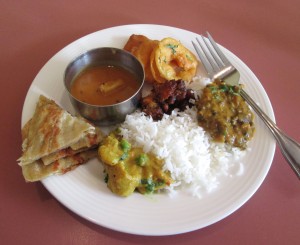
clockwise: mixed pekora, dal makani, white rice, vegetable korma, paratha, sambar, & vegetable manchunn
At the buffet table itself, customers can assemble their own papri chaat, a popular street-food in India that consists of fried doughy wafers topped with chickpeas, chilis, yogurt, and tamarind chutney. Other opening salvos include idli, light airy disks made from steaming the same dosa batter, that are dipped or immersed in sambar, a soup spiked with tarmarind. Other selections include vegetable korma, a saucy stewy mix of vegetables simmered in stock and yogurt that is eaten with rice; paneer makani, consisting of non-melting cubes of cheese (that, incidentally, look like tofu) in a rich, butter-infused sauce. The korma is customarily eaten with paratha, a Northern Indian flatbread. The main desserts are kheer, a creamy rice pudding made with vermicelli, milk, and sugar and gajar halwa, a sticky, clumpy dessert of sweetened grated carrots. Everything is on target; nothing disappoints—most notably the desserts that punctuate the meal.
With a full belly, one may be inclined to explore other aspects of the Takoma/Langley Crossroads. There are ethnic grocers as well as clothiers, banks, cell phone stores, and salons that cater to the surrounding community. And, given how readily one municipality blends into another around these parts, the bustling sprawl of ethnic businesses and their food options certainly don’t end with Takoma or Langley Park but spread duly eastward from the Crossroads into neighboring Hyattsville where Peruvian pollo a la brasa, Vietnamese phở and bánh mì, and even more Salvadorean treats can be found. But, undoubtedly, having just eaten a roti, pupusa, or one too many dosas, that’s likely an excursion for another day.
Copyright 2014 (Corbo Eng). All rights reserved.
All photos by Corbo Eng.

